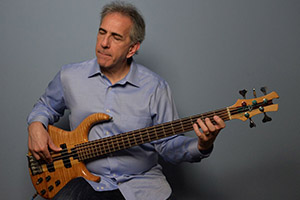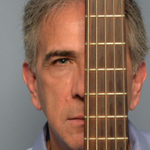Approaching bass mastery, from one end to the other
By Jon Liebman
Week of August 5, 2019
This week we published another thoroughly entertaining interview with the one and only Ralphe Armstrong, alumnus of the Mahavishnu, Frank Zappa, and Jean-Luc Ponty bands. It’s always fun catching up with Ralphe, and this time was no exception. The always upbeat Ralphe told me all about his upcoming record with Narada Michael Walden and other special friends, which they plan to work on for an entire year. He also described his large collection of basses, one by one, in detail.
When I asked him to offer advice to FBPO students about bass technique, Ralphe responded immediately, and adamantly. Obviously, playing bass is a two-handed endeavor, but Ralphe, in his response, focused on one hand, almost exclusively.
First, as bass players, we all know how much time and effort we need to put in to having our fingers in just the right places, on the proper frets, making smooth shifts, occasionally exerting acrobatic-like movements. Naturally, 5- and 6-string basses present additional challenges for the left hand. Fretless basses force us to concentrate not only on all of the above, but on playing in tune too.
At the same time, the plucking hand requires its share of concentration, whether it be regarding articulation, palm muting, thumb slapping, playing close to the neck, close to the bridge, negotiating those old-school pickup guards (I still don’t understand how – or why! – guys like Will Lee and Marcus Miller choose to leave those on some of their basses; I guess it’s just a matter of getting used to them), employing James Jamerson’s single-finger technique, or Billy Sheehan’s dazzling 3-finger displays, and so on. I love the upright slap techniques of Milt Hinton and Lee Rocker too!
And we can’t forget about two-handed tapping, a la Victor Wooten, Brad Russell, Stu Hamm, Brian Bromberg, and the rest.
But Ralphe remained ever focused on just one thing in his reply, proclaiming, resolutely, “One thing that’s definitely missing is the left-hand technique. That’s paramount.” He went on to stress the importance of keeping your second finger perfectly aligned with your thumb for making a better sound with the bass. As “evidence” of his declaration, he cited James Jamerson, Ron Carter, and Jaco Pastorius as bass players mindful of the right touch. We also talked about various ways of applying upright fingerings to the electric bass. It was a truly fascinating and enlightening conversation.
We cover a lot of these topics in our online lessons here on FBPO. The bottom line (pun intended!) is to master the elements of proper technique, but as a means to an end. Sure, we cover scales and modes, as well as right-hand speed drills with our students, but technique just for the sake of technique gets old very fast. What’s important is what we do with all those skills and that proficiency, and how to apply all that bass prowess toward making music. Nearly 100% of the time, that’s a skill that takes two hands.
If you have a thought on left-handed and/or right-handed bass technique, leave a comment and share it below. In the meantime, check out my interview with Ralphe here.






Both have always been of equal importance and for different reasons I believe. It is like a balanced set of scales (as in weight). One compliments the other in order to level out.
It is possible to be stronger in one than another and also like Matt Garrison, to use 4 fingers on the string-playing hand.
If only one hand is developed, the other suffers.